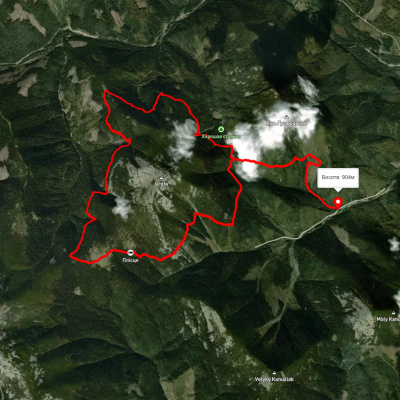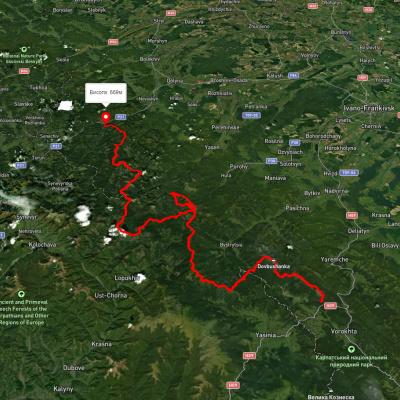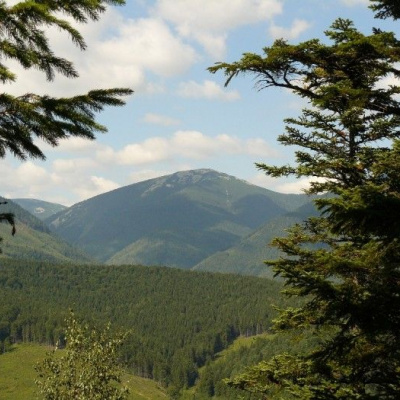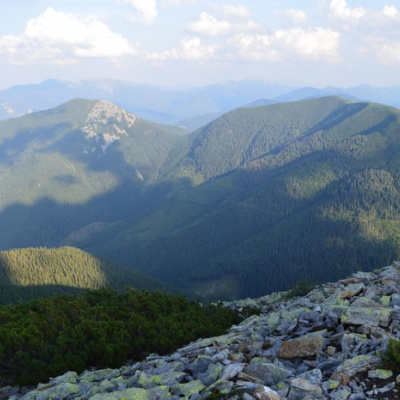Grofa landscape reserve
If there is a river on the reserve's territory that is considered one of the cleanest in Europe, it says a lot about the area. This is exactly what the Limnitsa is, with the lands of the landscape reserve located in the upper part of its basin.
The Grofa Nature Reserve is located on the Gorgan mountain range. Its peak, Mount Grofa (1748 meters above sea level), is only three hundred meters below Hoverla, the highest point in Ukraine. According to one version, the interesting and at the same time unusual-sounding name of Mount Grofa appeared on behalf of a Polish explorer, and according to another - thanks to the legend of an Austrian count. You can climb to Grofa from the village of Osmoloda along the Kotelets River or via Mount Kin.
The area is 2533.8 hectares. Created in 1996 on the site of the former first national park, founded in 1935 by Metropolitan Andrey Sheptytsky, to protect the unique landscape of Gorgan, large areas of spruce forests with an admixture of cedar pine, mountain pine ceilings, and populations of other rare plants listed in the Red Book of Ukraine. It covers the slopes of the mountain range with the peaks of Kin Grofetskyi, Grofa, Parenky, Petros (1000-1750 meters above sea level). The Mshana bog is also of great interest in the reserve.
The natural complexes of the reserve are a single mountain massif composed of coarsely layered massive sandstones. It stretches from north to south in the form of a ridge, which includes the peaks of Kin, Grofa, Parenky (1735 meters), Mala Popadia (1587 meters), Popadia (1740 meters), Studenets (1600 meters), Petros, Big and Small Kanyuky. Several times the mountain ridge is interrupted by saddles in the places of thin-core rhythmic flysch. The soils in the reserve are predominantly dark brown forest, sandy loam, and dark brown, peaty soils.
Vegetation of the reserve is represented mainly by mono-dominant mountain spruce (18.7%), spruce with relict cedar pine (20.2%), mountain pine stands (35.4%), mixed beech-fir-fir forests (0.6%). The rest of the territory is occupied by mountain meadows and stone placers (25.2%). Forest ecosystems are typical of the Gorgan in terms of typology. Wet spruce-bilberry-moss forests are widespread here; the average height of the stands reaches 18 m, diameter - 25 cm, age - 115 years, stock 262 m3/ha; wet cedar-pine-plumed forests are plain-bilberry forests; their average height of trees reaches 19 m, diameter - 26 cm, age - 113 years, stock 290 m3/ha.
The mountain pine stands occupy mostly rocky steep slopes. In the highlands, in large subalpine meadows, among the pine forests, one can find small groups of speckled gentian (Gentiana punctata L.).
Vegetation of the meadows is represented mainly by post-forest shiucca (Deschampsietum caespitosae), brome (Galamagrostidetum villosae) and white-woods (Nardetum strictae) meadows. They contain such Red Data Book species as Grokus heuffelianus Herb. and Arneka montana. Fragmentary herbaceous and shrubby diffuse communities, which deserve special recognition, are found on the rocky placers.
The reserve is particularly valuable for its extensive population of European cedar pine, which is listed in the Red Data Book of Ukraine. It is spread over an area of more than 500 hectares, which is 20% of the total area of the reserve. The grass cover also includes such rare Red Data Book species as the forest lily and the summer plumage.
Spruce forests are typical for Gorgan. On the edges, clumps of snowdrop and spring snowdrop, which are protected species, are often found. The forests within the reserve are primeval in age structure, but they have been affected by logging in the recent past. That is, up to an altitude of 1300 meters above sea level, the forests have already been cut down once. Today, the 100-year-old forests growing there are derivative communities that are similar in structure to virgin forests. However, compared to the surrounding territory of the Osmolodsk State Forestry, these forest natural complexes represent the nature of the Gorgan Mountains to the fullest extent possible and are therefore worthy of protection.
The marsh complexes in the Stav tract are of particular interest. However, they have not yet been investigated. Of great scientific value are the small areas of mountain pine stands among the spruce forest at an altitude of only 1100 meters. These are relics of the Ice Age, as they have been preserved in conditions of relatively recent relief formation, i.e. on the slope of a small terminal moraine, and are unique natural phenomena in the Gorgan Mountains.
The species composition of the reserve's forest fauna is rich, represented by animal complexes of deer, roe deer, bear, hare, and grouse.
The natural complexes of the reserve are significantly affected by natural processes, especially avalanches. About 10% of the forest area is covered by avalanche chutes, which are on average 50 meters wide and up to 100 meters long. Avalanche cones periodically block the Kotelets River valley.
This mountain range has been attracting tourists for more than 100 years due to its picturesque and original landscapes and locally present wildlife. Nowadays, it is mostly amateur tourists who visit the area. Amateur recreationalists visit the Plisce and Stav tracts especially often, and unfortunately, they often damage buildings and pollute the area.
A differentiated environmental protection regime should be introduced on the territory of the reserve. Forest ecosystems of virgin nature should be fully protected. In partially modified and derivative stands, forestry should be conducted in the direction of reproducing the coenotic structure of indigenous ecosystems. Special studies and conservation zoning should be conducted to justify a differentiated conservation regime on the reserve's territory. A single route should be defined for tourists and equipped with rest stops. Visits to the reserve by tourists should be regulated depending on the time of year.
Regulations on the Grofa landscape reserve of national importance in the new version
Accommodation around Grofa landscape reserve:
Які маршрути проходять повз Grofa landscape reserve?
Пропонуємо пройти такі туристичні (пішохідні) маршрути через/біля Grofa landscape reserve: Екостежка довкола Грофи , Східно-Карпатський туристичний шлях, с. Осмолода – г. Грофа – с. Осмолода, с. Осмолода, через г. Грофа, г. Паренки, г. Коретвина, г. Попадя до с. Осмолода, с. Татарів, через г. Синяк, г. Довбушанка, г. Чорна Клева, г. Братківська, г. Сивуля, г. Кінець Горгану, г. Попадя, г. Грофа до с. Мислівка, м. Рахів, через г. Близниця, г. Трояска, г. Братківська до с. Осмолода

Екостежка довкола Грофи

Східно-Карпатський туристичний шлях

с. Осмолода – г. Грофа – с. Осмолода

с. Осмолода, через г. Грофа, г. Паренки, г. Коретвина, г. Попадя до с. Осмолода




